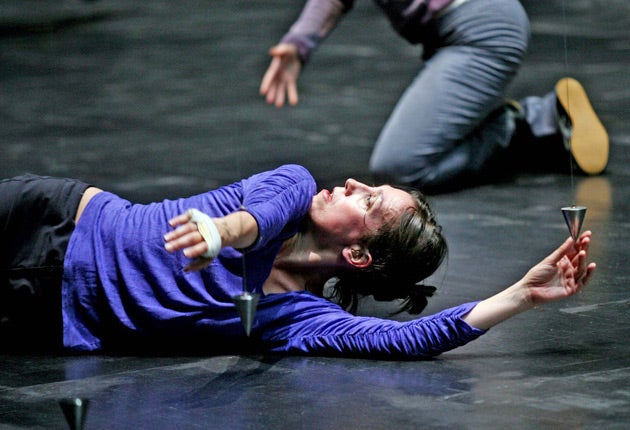Nowhere and Everywhere at the Same Time, Turbine Hall, Tate Modern London

Hundreds of pendulums hang in the huge Turbine Hall of Tate Modern. They're delicate things, polished steel cones hanging by metal threads, rather than something from a grandfather clock or Edgar Allan Poe. William Forsythe's dancers weave in and out, setting them swinging, gently stopping them.
The Sadler's Wells Focus on Forsythe comes to a close with art installations, some of the finest work in the season. For Nowhere and Everywhere at the Same Time, a piece about gravity and momentum, half of the Turbine Hall is set aside as a dancing space, with the audience watching from the edges or from the bridge across the Hall.
Forsythe's setting, realised by Max Schubert, shows off the scale of this space. The weights hang a few inches from the floor. The gleaming threads stretch upwards, almost to the full height of the hall. The dancing is lit by electric lamps, and by the changing spring light that comes through the Turbine Hall's long skylights. Thom Willems's music hums and sighs.
Having a stage this big, and an audience this close, means that you see dancing in the far distance and right under your nose. The performers sprint flat out through this huge space, or wind their way around a single wire. They'll take care not to touch a thread, or deliberately set the pendulums swinging.
Throughout, Forsythe's dancers are beautifully absorbed in their work. I've never seen them so relaxed, so unself-conscious. One woman tilts an arm, a hip, as if trying out movements in a classroom mirror. A man paces back and forth, setting different pendulums swinging in unison. They're humans looking at the laws of physics: contemplative, with some vertiginous plunges.
The range of movement is considerable. Several dancers burst into hopscotch, jumping from one foot to another. There are classical jumps, and wriggling moves. Solos slip into duets and group dances. One man lies down under a weight, holding his stomach muscles in to give it room to move freely.
Forsythe leaves his dancers, and his audience, to explore gravity, without pointing out meanings or morals. It's a spacious, precise and assured piece. Performance over, members of the audience can't resist. All around the hall, people lean forward to touch a pendulum, just enough to make it swing.
Subscribe to Independent Premium to bookmark this article
Want to bookmark your favourite articles and stories to read or reference later? Start your Independent Premium subscription today.

Join our commenting forum
Join thought-provoking conversations, follow other Independent readers and see their replies